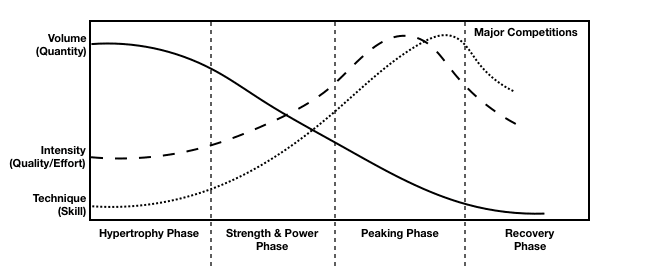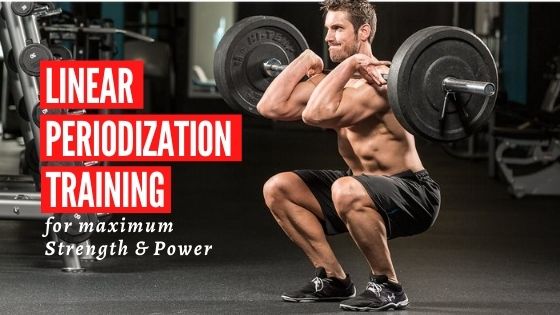If you want to do progress in the gym by increasing your muscular strength, you must have a well-designed science-based training program. And that’s where linear periodization comes into play.
However, three types of periodization schemes are available (linear, reverse linear, and undulating periodization). But this article explains only about linear periodization training scheme: Why you should use this? How to use it? and some sample training plans.
What Is Linear Periodization?
The term ‘periodization’ means systematic manipulation of the stress that you provide to your muscles. You can do this by manipulating different training variables like the weight that you lift, training intensity, etc. This process can go for a period of some days to several months.
Among different periodization techniques, it is the most famous type of periodization scheme. This is why it is also known as classic periodization.
In simple words, linear periodization is a progression model in which you gradually increase training intensity while decreasing the volume.
Why Should You Use It?
This is one of the well-researched periodization training schemes and used all over the world by various athletes and Olympic lifters.
Regardless of your experience, periodized training protocols are more effective than non-periodized training protocols for increasing strength, power, and athletic performance.
This periodization technique mainly focuses on increasing your muscular strength and power. And due to its effectiveness, most strength coaches use this scheme.
Hence, if your primary goal is to increase strength and power, you must try linear periodization in your workout program.
This works best for beginners also as they don’t need much stimulus to do progress. Also, if you are not experiencing any growth in your muscular strength, you can switch to this training program.
This can be a good plan of attack to break the plateau.
How It Works?
This periodization scheme divides the complete training program of about six months to one year into small phases called mesocycles. Each mesocycle lasts for several weeks to months.
These mesocycles are further divided into microcycles which last for a week.
The training starts from the low intensity and high volume. As the mesocycle continues, the intensity keeps on increases while volume decreases. You can see an overview of the classic periodization training in the following figure.

Linear or classic periodization training consists of 4 mesocycles (phases). Every phase gives a different stimulation to your muscles and ultimately gives a significant increase in your strength and power.
Each phase lasts for 3 weeks to 1 month and after finishing all the phases, this cycle repeats itself. You can also try a compressed version of this program by running each phase only for one or two weeks.
Let’s discuss the training pattern of each mesocycle in detail.
1st Mesocycle (Hypertrophy phase)
As you can see in the figure, the training starts with the hypertrophy phase (first mesocycle) of low intensity and high volume.
In this phase, you do about 4 to 5 sets for each exercise. And most of the sets remain in the hypertrophy rep range, 8-12 reps per set with about two minutes rest in between the sets. Hence, the overall training volume becomes very high.
You can call this phase the hypertrophy phase as the main goal is to maximize muscle hypertrophy. This muscle mass you gain in this phase is to enhance your performance in the strength and power phase which is the next mesocycle.
2nd Mesocycle (Strength & Power phase)
The next mesocycle is the strength phase which focuses on maximizing muscle strength and power. In this phase, the intensity is higher and volume is lower than in the previous phase.
For maximum strength gain, you would have to perform 3 to 4 sets of every exercise. Rep range would be lower (2-6 reps per set) with about three minutes of rest in between the sets.
In the next phase, you further increase the intensity while reducing volume. This phase is the power phase where you get the benefits from the last two phases.
The number of sets remains usually 3 for every exercise with two to three reps per set. As you are lifting super heavyweights, the rest between the sets are also higher (3-5 minutes).
The major purpose of this phase is to start transferring the gains you get from hypertrophy and strength phases into more explosive power.
3rd Mesocycle (Peak phase)
This phase is the final weight training phase that prepares you for the competition. All you get from the beginning of linear periodization training boils down to this peak phase.
In this phase, the intensity is the highest which means you lift the heaviest weight possible (1 RM) and the volume is at its lowest.
You perform one to three sets for each exercise and just one rep per set. You have to put all your energy into your lifts and give your peak performance in this phase.
These are the strength gains that you achieve through this linear periodization training protocol.
4th Mesocycle (Active Rest)
This is the last mesocycle of this linear periodization workout program. As the name suggests, you take an active rest in this phase. That means, stay away from any kind of weight training or resistance training but still being active.
In this phase, you can do jogging, cycling, swimming, or play any sport like football, volleyball, basketball, etc. In simple terms, any kind of activity except strength training.
This phase should last for one to two weeks. The purpose of this phase is to give some rest to your body from the continuous fatigue of heavy training.
The cycle also ends with the end of this phase. Keep repeating this cycle until you stop getting results.
Pros And Cons Of Linear Periodization
Pros
1. If you are preparing for a weightlifting competition or your goal is to gain muscular strength and power, linear periodization is one of the best workout programs.
2. It’s a very safe and effective strength training program for beginners. In the first mesocycle, you can master the form with moderate weights and then easily progress for the next phases with heavyweights.
3. If you are getting plateau in your gains, this periodized training protocol can help you break the plateau.
4. Lastly, it’s a very simple and result-oriented periodization technique. If you don’t want any complicated training program then you can choose this one.
Cons
1. Linear periodization doesn’t work well for advanced-level athletes as they don’t adapt easily. They need more variations and more stimulus to do progress.
2. Another drawback of this training protocol is that if you follow the high-volume training phases for too long, it may lead to fatigue.
3. The muscle mass you gain during the hypertrophy phase may not be lost during the other mesocycles. So if your primary goal is to gain muscle faster, then this program is not for you.
This is the main drawback of linear periodization for bodybuilders or athletes who want to gain muscle mass. Hence, other periodization training programs focus on building the maximum muscle mass possible.
Linear Periodization: SUMMARY
Struggling with your progress in the lifting room or want to gain strength and power, this linear periodization is a great program for you.
It usually runs for several months to a few years. One complete cycle of this program consists of 4 mesocycles in which you start with high volume and low-intensity training. As the program continues, volume keeps decreases, and intensity increases.
- 1. First mesocycle starts with hypertrophy phase. It consists of maximum volume and low intensity (4-5 sets per exercise and 8-12 reps per set)
- 2. Second mesocycle consists of strength and power phase.
- In strength phase, you train with comparatively high intensity and low volume then phase 1 (3-4 sets per exercise and 3-6 reps per set)
- In power phase, intensity further increases and you get the benefits of gains from first two phases (3 sets per exercise and 1-3 reps per set)
- 3. Third mesocycle is the peak phase where you lift the maximum weights possible (3 sets, 1 rep each set).
- 4. The last phase is active rest phase which runs for 1-2 weeks. In this phase you can do any physical activity except strength training.
After all four mesocycles, you can restart the program again with more strength and power.
More on periodization:
Thanks for reading this so far. For any query regarding fitness, you can ask me in the comments. For daily fitness facts and motivation, please follow us on Instagram.


